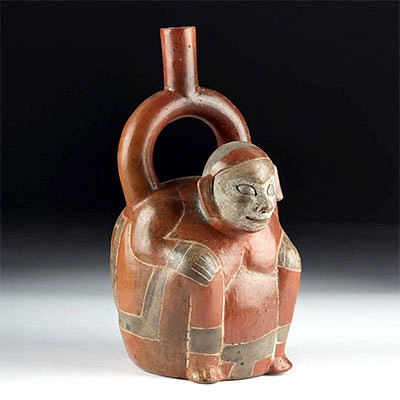Rare 19th C. Marshall Islands Fiber Currency - Ihrik
Lot 287
About Seller
Artemis Gallery
686 S Taylor Ave, Ste 106
Louisville, CO 80027
United States
Selling antiquities, ancient and ethnographic art online since 1993, Artemis Gallery specializes in Classical Antiquities (Egyptian, Greek, Roman, Near Eastern), Asian, Pre-Columbian, African / Tribal / Oceanographic art. Our extensive inventory includes pottery, stone, metal, wood, glass and textil...Read more
Estimate:
$1,600 - $2,400
Absentee vs Live bid
Two ways to bid:
- Leave a max absentee bid and the platform will bid on your behalf up to your maximum bid during the live auction.
- Bid live during the auction and your bids will be submitted real-time to the auctioneer.
Bid Increments
| Price | Bid Increment |
|---|---|
| $0 | $25 |
| $300 | $50 |
| $1,000 | $100 |
| $2,000 | $250 |
| $5,000 | $500 |
| $10,000 | $1,000 |
| $20,000 | $2,500 |
| $50,000 | $5,000 |
| $100,000 | $10,000 |
| $200,000 | $20,000 |
About Auction
By Artemis Gallery
Jul 8, 2021
Set Reminder
2021-07-08 10:00:00
2021-07-08 10:00:00
America/New_York
Bidsquare
Bidsquare : CLEARANCE | Ancient & Ethnographic Art
https://www.bidsquare.com/auctions/artemis-gallery/clearance-ancient-ethnographic-art-7173
Kick off summer with our clearance sale featuring discounted pricing and many new items at superb prices! Asian art, Classical antiquities from Egypt, Greece, Italy, and the Near East...plus Pre-Columbian, Tribal, Russian Icons & Enamelware, Spanish Colonial, Fine Art, Fossils, more! Artemis Gallery info@artemisgallery.com
Kick off summer with our clearance sale featuring discounted pricing and many new items at superb prices! Asian art, Classical antiquities from Egypt, Greece, Italy, and the Near East...plus Pre-Columbian, Tribal, Russian Icons & Enamelware, Spanish Colonial, Fine Art, Fossils, more! Artemis Gallery info@artemisgallery.com
- Lot Description
**Originally Listed At $900**
Oceania, Micronesia, Marshall Islands, ca. 19th century CE. A rare example of an ihrik, a plaitwork currency coil cord formed from a core of coconut sennet fibers bound with tightly braided palm leaf strips. The black and white braid work is incredibly precise with nearly even spacing between each dark and light ringlet, and one end terminates in a bulbous knot. Size (wrapped): 3.5" W x 3.375" H (8.9 cm x 8.6 cm); 3.875" H (9.8 cm) on included custom stand; (unwrapped): 51" L (129.5 cm)
According to ethnographic currency expert Charles Opitz, "Plaitwork of black and white palm leaf strips woven over a base of twisted coconut fiber cord were made by the natives. The coils were used as money and also worn as a girdle. The same technique of cylindrical plaitwork in short, stiffer lengths and in gaudier colors is used in the Solomons for ear-sticks." (Opitz, Charles J. "An Ethnographic Study of Traditional Money: A Definition of Money and Descriptions of Traditional Money." First Impressions Printing, Inc., Florida, 2000, p. 161)
For two examples and an illustration of ihrik cords, please see Opitz, Charles J. "An Ethnographic Study of Traditional Money: A Definition of Money and Descriptions of Traditional Money." First Impressions Printing, Inc., Florida, 2000, p. 161, bottom two plates.
Provenance: private Hawaii, USA collection; ex-Norman Hurst collection, Cambridge, Massachusetts, USA, acquired before 2000
All items legal to buy/sell under U.S. Statute covering cultural patrimony Code 2600, CHAPTER 14, and are guaranteed to be as described or your money back.
A Certificate of Authenticity will accompany all winning bids.
We ship worldwide and handle all shipping in-house for your convenience.
#154532Measured as a bundle as it is wrapped on one side and attached to stand. Knotted at one end and fraying to both ends, otherwise intact and very good. Nice remains of color throughout.Condition
- Shipping Info
-
All shipping is handled in-house for your convenience. Your invoice from Artemis Gallery will include shipping calculation instructions. If in doubt, please inquire BEFORE bidding for estimated shipping costs for individual items.
-
- Buyer's Premium



 EUR
EUR CAD
CAD AUD
AUD GBP
GBP MXN
MXN HKD
HKD CNY
CNY MYR
MYR SEK
SEK SGD
SGD CHF
CHF THB
THB















